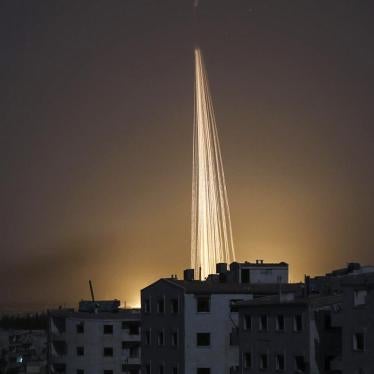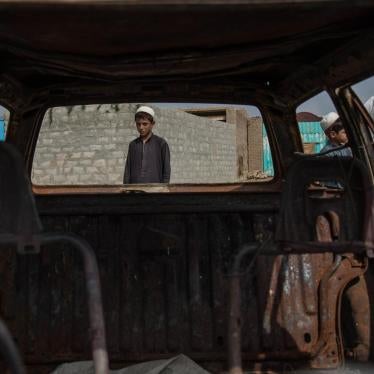May 15, 2017
James Mattis
Secretary of Defense
Department of Defense
1000 Defense Pentagon
Washington, D.C. 22202
Re: Civilian Protection in Afghanistan
Dear Secretary Mattis:
We write to urge the Department of Defense to prioritize the protection of civilians in all its activities in Afghanistan. We understand the US government is currently conducting a strategy review of support to the government of Afghanistan in its efforts against the Taliban, al Qaeda, and groups affiliated with the Islamic State. We believe measures to better protect civilians should be at the forefront of this review.
Human Rights Watch is a nongovernmental organization that works in over 90 countries around the world to promote respect for international human rights and humanitarian law by governments and non-state armed groups. We have long worked on the protection of civilians in conflict in Afghanistan. Our 2008 report, “Troops in Contact”: Airstrikes and Civilian Deaths in Afghanistan,[i] made a series of recommendations that we discussed in detail with the Department of Defense, some of which led to changes in procedures that led to greater protections of civilians.
As you know, civilian casualties in Afghanistan have steadily risen in recent years, and 2016 had the highest toll recorded with a total of 11,418 (3,498 deaths and 7,920 injured), according to the United Nations Assistance Mission to Afghanistan (UNAMA).[ii] While we are aware that the Taliban and other insurgent forces have caused most of these casualties through deliberate targeting and indiscriminate attacks, casualties caused by US and Afghan forces have also been on the rise. The recent report from the UNAMA shows that in 2016, aerial operations by US and Afghan government forces resulted in the deaths of 250 civilians and injuries to 340 others, which is double the total from the previous year.[iii] These incidents raise concerns that procedures to protect civilians from harm during US and Afghan government military operations are not adequate.
We understand that as of June 2016, the US military, under the NATO mission Resolute Support and the US mission Freedom’s Sentinel, has expanded airstrikes in Afghanistan and increased Special Forces operations in frontline areas such as Nangarhar, Helmand, and Kunduz. NATO forces participating in these missions have been authorized to strike Taliban targets in support of Afghan troops, and to accompany Afghan forces into the field to provide support. For air operations, we understand that the rules of engagement allow for close air-support strikes in self-defense when US or Afghan forces are threatened. Those airstrikes require US military air-controller personnel on the ground to identify targets and communicate with pilots overhead. Instances of high civilian losses have raised questions about the way targets are identified and what precautions taken to reduce civilian harm.
Such concerns were raised, for instance, by the airstrike in Boz-e Qandahar, Kunduz, on November 2-3, 2016, which killed 33 civilians and wounded 27. The Defense Department investigation determined that US forces “used the minimum amount of force required” to protect ground troops, and that the airstrikes targeted Taliban fighters who had been firing from residential buildings. However, it is not clear from the public statement if the investigation report (the details of which have not been released) examined whether the force used was proportionate or considered the risks of such targeting in a densely populated urban area. The Defense Department also did not provide information on whether disciplinary or remedial measures were taken as a result of its investigation.
We believe the US public should be better informed about the safeguards in place for this increased level of air operations to minimize harm to Afghan civilians in accordance with the laws of armed conflict and US rules of engagement. The US military has not indicated whether there have been any changes to the tactics, techniques, and procedures for airstrikes and, if so, whether they are connected to or separate from recent changes in the way coalition airstrikes are now vetted in both Iraq and Syria.[iv] We understand that the current civilian casualty (CIVCAS) cell for Iraq and Syria is composed of two people. It is not clear whether Afghanistan is included in the purview of this team or, if done separately, what the team is and if they share lessons learned. As you know, ISAF developed considerable expertise in the analysis of factors contributing to civilian casualties in Afghanistan before 2014, which should be relevant to operations there and in other theaters of operation today.
In addition, we are concerned that civilian casualties from aerial operations conducted by the Afghan Air Force have increased sharply in recent months. According to UNAMA, aerial operations remained the second leading cause of civilian casualties by Afghan government forces in 2016, causing 43 percent of civilian casualties.[v] As most Afghan air assets and training have been provided or facilitated by the US military, it is important that the Defense Department provide the public information on its efforts to address this disturbing trend. We are particularly concerned that civilian casualty Afghan tracking and mitigation measures are significantly lacking; and that the training of Afghan Tactical Air Coordinators (ATACs) lags far behind what is needed as aerial operations increase.
We would be grateful to meet with members of your staff to discuss these concerns.
Thank you for considering our request.
Sincerely,
Sarah Margon
Washington Director
Brad Adams
Asia Director
[i] Human Rights Watch, “Troops in Contact”: Airstrikes and Civilian Deaths in Afghanistan, 2008, https://www.hrw.org/reports/2008/afghanistan0908/. Key recommendations included: ensure air attacks comply with the obligation to take all feasible precautions to minimize harm to the civilian population; adopt measures to reduce the likelihood of civilian casualties in “Troops in Contact” (TIC) situations; do not carry out airstrikes without an adequate collateral damage estimate (CDE); trained Joint Terminal Air Controllers (JTACs) should be involved in all TIC airstrikes; do not carry out airstrikes in densely populated areas unless the intelligence is highly reliable and the target has been visually identified; carry out a thorough investigation of the collateral damage and battle damage assessment processes to determine how they can be improved to reduce civilian casualties and implement appropriate changes; use precision-guided low-collateral-damage munitions whenever possible, especially on military targets in populated areas; adopt Rules of Engagement (ROE) that are consistent to ensure that differences in ROE do not result in unnecessary civilian casualties; provide accurate information on civilian casualties in military operations; accept responsibility for civilian deaths and injuries as soon as possible while refraining from denying responsibility for civilian loss until an after-battle investigation has been conducted; create an officer-level position or office charged with monitoring, investigating, compensating, and publicly reporting on all incidents of civilian casualties that works directly with the Afghan government to ensure accurate accountability; and provide timely and adequate compensation to victims of airstrikes.
[ii] United Nations Assistance Mission to Afghanistan (UNAMA), “Afghanistan Annual Report on Protection of Civilians in Armed Conflict: 2016.
[iii] Ibid., pp. 82-83.
[iv] Human Rights Watch, “Iraq: Airstrike Vetting Changes Raise Concerns,” March 28, 2017, https://www.hrw.org/news/2017/03/28/iraq-airstrike-vetting-changes-raise-concerns
[v] United Nations Assistance Mission to Afghanistan (UNAMA), “Afghanistan Annual Report on Protection of Civilians in Armed Conflict: 2016, p. 83.






